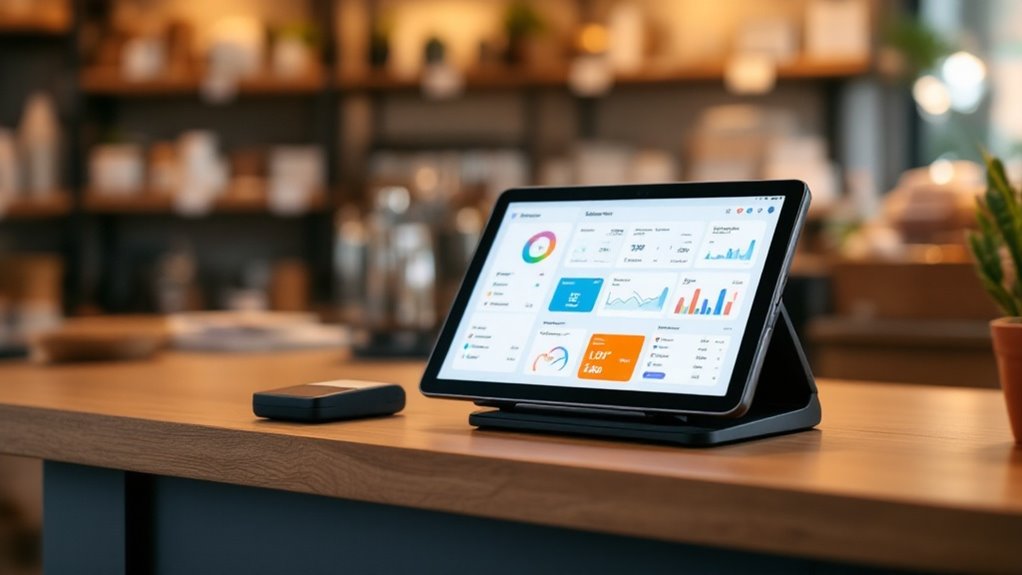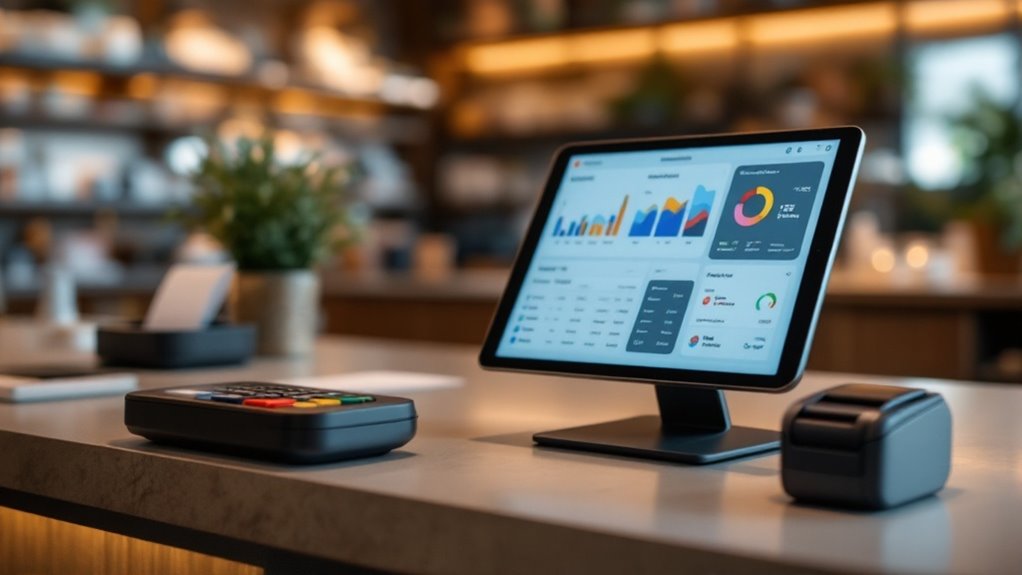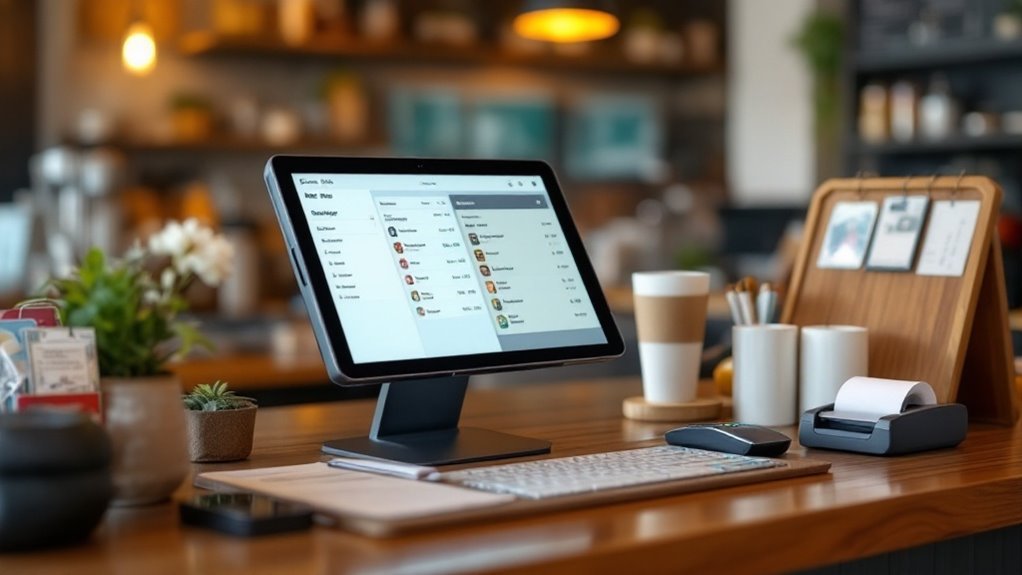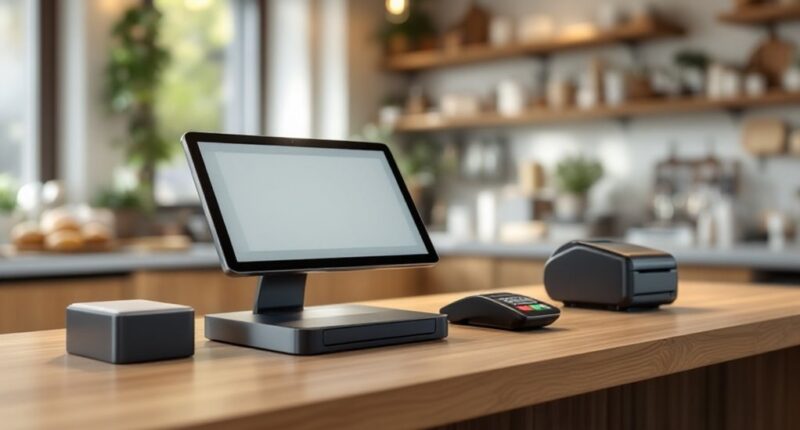POS software combines payment processing, inventory tracking, and customer management tools essential for small businesses. Modern systems offer real-time inventory monitoring, sales analytics, and multi-channel integration for both online and in-store sales. Popular solutions like Shopify POS typically charge 2.49-2.7% per transaction while providing features such as employee scheduling and loyalty programs. The right system depends on specific industry needs, transaction volume, and growth plans. Exploring industry-specific options can boost operational efficiency by up to 30%.
Quick Overview
- Choose a POS system with essential features like inventory tracking, sales analytics, and customer management without paying for unnecessary extras.
- Look for providers offering transparent pricing structures with reasonable processing fees between 2.49% to 2.7% per transaction.
- Ensure the POS software includes cloud capabilities for remote access and automatic data backups to protect business operations.
- Select a solution that integrates smoothly with existing business tools and offers room for growth as your business expands.
- Consider industry-specific POS solutions that can increase operational efficiency by up to 30% compared to generic systems.
Understanding POS Software Essentials for Small Business Success

Three key elements define modern Point of Sale (POS) software: efficiency, integration, and adaptability. For small businesses, these elements translate into essential components that drive daily operations and growth. Modern POS systems combine transaction processing, inventory management, and customer relationship tools into a unified platform. Popular solutions like Shopify POS offer seamless integration between online and physical retail operations.
The core functionality extends beyond simple sales processing. Today’s POS solutions offer:
Modern POS systems transcend basic transactions, delivering comprehensive business solutions that transform how companies operate and grow.
- Real-time inventory tracking
- Customer data analysis
- Multi-channel selling capabilities
- Performance analytics
- Accounting software integration
Small businesses benefit from both cloud-based and traditional on-premise options, with mobile and tablet solutions providing flexibility for various operations. With processing fees ranging from 2.49% to 2.7% per transaction across major providers, businesses can choose solutions that fit their budget and operational needs.
When implemented correctly, POS software streamlines operations, reduces human error, and provides valuable business insights. The key is selecting a system that aligns with specific business needs while offering room for future growth.
Top POS System Features That Drive Business Growth
Modern POS systems offer a robust set of features that can greatly accelerate business growth and improve operational efficiency.
Five key features stand out as major drivers of business success:
First, inventory management tools enable real-time stock tracking and automatic reordering, preventing costly stockouts. Small businesses can leverage real-time data analytics to make informed inventory decisions and maintain optimal stock levels.
Second, advanced sales analytics provide detailed insights into product performance and customer behavior through customizable dashboards.
Third, thorough CRM capabilities help build customer loyalty through personalized rewards and targeted marketing campaigns.
Fourth, multi-channel sales integration guarantees seamless operations across in-store, online, and mobile platforms.
Finally, employee management features track staff performance and streamline scheduling.
These integrated capabilities transform a basic POS system into a powerful business management tool that drives growth through improved efficiency and customer satisfaction.
Selecting the Right POS Provider: A Cost-Benefit Analysis

Selecting the right POS provider requires careful evaluation of both immediate costs and long-term benefits for a small business. When analyzing providers, businesses should examine five key factors: total cost of ownership, provider stability, system flexibility, support services, and contract terms.
The total cost analysis should include not just upfront expenses, but also monthly fees, transaction costs, and potential future charges. A system with cloud-based capabilities offers greater cost efficiency and accessibility compared to traditional on-premise solutions.
Financial stability indicators, such as the provider’s Dun & Bradstreet rating and industry experience, help guarantee long-term reliability.
System scalability becomes vital as businesses grow, making it essential to choose solutions that can expand across multiple locations.
Quality support services, including 24/7 help desk access and extensive training, protect daily operations.
Finally, transparent contract terms and positive customer references validate the provider’s reputation and commitment to service excellence.
Industry-Specific POS Solutions and Their Impact
While generic POS systems can meet basic business needs, industry-specific solutions deliver targeted features that dramatically enhance operational efficiency and customer experience.
Different sectors require unique functionalities – retail businesses benefit from inventory management and loyalty programs, while restaurants need table management and kitchen display systems. Grocery stores rely on scale integration and fresh produce tracking. With over 10,000 customers already utilizing these specialized systems, the proven track record demonstrates widespread adoption across various industries.
Each industry demands its own POS features – from retail inventory tracking to restaurant table management to grocery store produce monitoring.
Research shows businesses using industry-specific POS systems report a 30% increase in operational efficiency.
These specialized solutions offer:
- Custom reporting tailored to industry metrics
- Integration with sector-specific software
- Mobile capabilities for flexible operations
- Compliance features for regulations
- Real-time data access for better decision-making
The market for these solutions continues to grow, with retail alone accounting for 34.35% of overall POS market revenue.
Implementation Strategies and Best Practices

Successful POS implementation requires a structured, methodical approach that considers every aspect of a business’s operations. Small businesses should begin by thoroughly evaluating their needs, considering factors like transaction volume, inventory complexity, and required integrations. Real-time inventory tracking capabilities are essential for maintaining accurate stock levels and preventing stockouts.
A clear implementation timeline helps guarantee smooth deployment. This includes setting milestones, scheduling hardware installation, and planning extensive staff training.
When selecting a POS system, businesses should prioritize scalability and cloud capabilities while confirming the solution aligns with their specific requirements.
The implementation process culminates in thorough testing and staff training, followed by a carefully monitored launch phase. Regular system optimization, performance monitoring, and ongoing staff education help maximize the POS system’s value.
Frequently Asked Questions
Can I Use My Existing Hardware With a New POS System?
Many businesses can continue using their existing hardware with a new POS system, but compatibility checks are essential.
Common equipment like cash drawers, receipt printers, and barcode scanners often work across different systems. However, factors like operating system requirements, processor capabilities, and driver compatibility need verification.
It’s recommended to:
- Review hardware specifications
- Check manufacturer compatibility lists
- Confirm peripheral device support
- Consider performance requirements
What Happens to My POS Data if the Internet Connection Fails?
Modern POS systems are designed to handle internet outages seamlessly.
When connectivity fails, the system automatically switches to offline mode, storing all transaction data locally on the device.
Sales can continue as normal, with the system securely saving payment information, inventory changes, and customer data.
Once internet connection resumes, the POS automatically syncs all offline activity with the cloud database, ensuring no data is lost during the outage period.
How Long Does It Typically Take to Train Staff on POS Software?
Staff typically require 1-2 weeks to learn basic POS operations, while thorough system mastery takes 2-4 weeks.
Training duration varies based on several factors:
- System complexity
- Employee’s tech-savviness
- Prior POS experience
- Quality of training materials
- Hands-on practice opportunities
Best results come from combining hands-on practice, role-playing scenarios, and interactive tutorials.
Regular refresher sessions and ongoing support help maintain proficiency and address system updates or new features.
Are There Seasonal Pricing Options for Businesses With Fluctuating Sales Volumes?
Yes, several seasonal pricing options are available for businesses with fluctuating sales volumes.
Providers offer flexible payment structures including pay-as-you-go rates (0.7-2% of sales), pausable payments during off-season, and percentage-based pricing models.
These options help businesses manage costs during slow periods while scaling up during peak seasons.
Companies like NCC, High Trek POS, and Square provide these adaptable solutions, allowing businesses to pay only for what they use when operational.
Can Multiple Business Locations Share a Single POS Database?
While some businesses struggle to coordinate multiple locations, modern POS systems actually excel at database sharing.
Multiple locations can seamlessly share a single database through cloud-based solutions, enabling real-time synchronization of inventory, sales data, and customer information.
This centralized approach offers unified reporting, consistent pricing, and streamlined operations across all stores.
However, reliable internet connectivity and proper security measures are essential for successful implementation.
Conclusion
Like a skilled conductor orchestrating various instruments, the right POS system harmonizes all aspects of a small business’s operations. Selecting and implementing appropriate POS software requires careful consideration of features, costs, and industry requirements, but the rewards are substantial. When properly deployed, these systems streamline operations, enhance customer experience, and provide valuable insights that help small businesses compete effectively in today’s digital marketplace.








